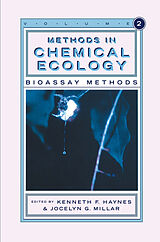Methods in Chemical Ecology Volume 2
Einband:
Fester Einband
EAN:
9780412080418
Untertitel:
Bioassay Methods
Herausgeber:
Springer US
Auflage:
1998
Anzahl Seiten:
432
Erscheinungsdatum:
30.06.1998
ISBN:
0412080419
Identification of chemicals that affect the naturally occurring interactions be tween organisms requires sophisticated chemical techniques, such as those docu mented in volume 1, in combination with effective bioassays. Without an effective bioassay, the identification becomes akin to looking for a needle in a haystack, but without any idea of what a needle looks like. To a large extent serniochemical identifications must be driven by bioassays. The design of bioassays for use in chemical ecology is governed by the sometimes conflicting objectives of ecological relevance and the need for simplic ity. Bioassay design should be based on observations of the interactions between organisms in their natural context, a theme that appears throughout this volume. As a result, this volume is as much about ecology and behavior as it is about specific methods. It is impossible to design a relevant bioassay, whether it is simple or complex, without understanding at least the fundamentals of how chemical cues or signals mediate the interaction in nature. Thus, the development of bioassay methods must be driven by an understanding of ecology and a knowledge of the natural history of the organisms under study. Given such an understanding, it is often possible to design assays that are both ecologically relevant and easy to perform.
Autorentext
Kenneth F. Haynes is a Professor of Entomology in the Department of Entomology, University of Kentucky, Lexington, Kentucky.
Inhalt
1. Bioassays with marine microorganisms.- 1.1. Chemical ecology of marine microorganisms.- 1.2. Ecological relevance of bioassays.- 1.3. Antimicrobial assays.- 1.4. Behavioral assays.- 1.5. Summary and conclusions.- 1.6. Acknowledgments.- 1.7. References.- 2. Bioassays with marine and freshwater macroorganisms.- 2.1. Introduction.- 2.2. Foraging cues.- 2.3. Feeding cues.- 2.4. Consequences of consuming defensive metabolites.- 2.5. Toxin-mediated prey capture.- 2.6. Chemically mediated detection of and responses to predators.- 2.7. Intraspecific chemical communication.- 2.8. Chemically mediated homing behavior.- 2.9. Settlement cues.- 2.10. Allelopathy and antifouling.- 2.11. Chemical ecology within a broader environmental context.- 2.12. Conclusions.- 2.13. Acknowledgments.- 2.14. References.- 3. Bioassay methods for fungi and oomycetes.- 3.1. Introduction.- 3.2. Intraspecific interactionsreproduction.- 3.3. Intraspecific population interactions.- 3.4. Interspecific interactions.- 3.5. Conclusions.- 3.6. Acknowledgments.- 3.7. References.- 4. Bioassays for allelopathy in terrestrial plant.- 4.1. Introduction.- 4.2. Case studies illustrating appropriate bioassays.- 4.3. Density-dependent phytotoxicity.- 4.4. Practical considerations.- 4.5. Acknowledgments.- 4.6. References.- 5. Bioassay methods with terrestrial invertebrates.- 5.1. Introduction.- 5.2. Behavioral bioassays for odors, pheromones, and other volatile compounds.- 5.3. Bioassays for contact oviposition stimulantstwo case studies.- 5.4. Measurement of preference.- 5.5. Postingestive bioassays.- 5.6. Measurements in diet studies: growth rate, consumption rate, and efficiency of conversion of food to biomass.- 5.7. Alternative methods to separate preingestive and postingestive effects.- 5.8. Contact andvolatile toxicity.- 5.9. Conclusions.- 5.10. Acknowledgments.- 5.11. References.- 6. Bioassay methods for amphibians and reptiles.- 6.1. Introduction.- 6.2. Amphibians.- 6.3. Reptiles.- 6.4. Conclusions.- 6.5. Acknowledgments.- 6.6. References.- 7. Bioassays for mammals and birds.- 7.1. Introduction.- 7.2. Chemical senses.- 7.3. Test paradigms.- 7.4. Experimental apparatus.- 7.5. Intraspecific behaviors.- 7.6. Interspecific behaviors.- 7.7. Case studies.- 7.8. Summary.- 7.9. Acknowledgments.- 7.10. References.

Leider konnten wir für diesen Artikel keine Preise ermitteln ...
billigbuch.ch sucht jetzt für Sie die besten Angebote ...
Die aktuellen Verkaufspreise von 6 Onlineshops werden in Realtime abgefragt.
Sie können das gewünschte Produkt anschliessend direkt beim Anbieter Ihrer Wahl bestellen.
Loading...
Die aktuellen Verkaufspreise von 6 Onlineshops werden in Realtime abgefragt.
Sie können das gewünschte Produkt anschliessend direkt beim Anbieter Ihrer Wahl bestellen.
| # | Onlineshop | Preis CHF | Versand CHF | Total CHF | ||
|---|---|---|---|---|---|---|
| 1 | Seller | 0.00 | 0.00 | 0.00 |
